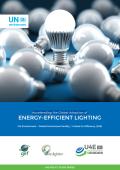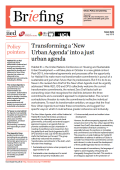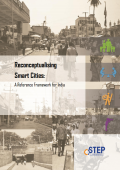
Climate change will affect all types of infrastructure, including energy, transport and water. Rising temperatures, increased flood risk and other potential hazards will threaten the reliable and efficient operation of these networks, with potentially large economic and social impacts. Decisions made now about the design, location and operation of infrastructure will determine how resilient they will be to a changing climate.
This paper provides a framework for action aimed at national policymakers in OECD countries to help them ensure new and existing infrastructure is resilient to climate change. It examines national governments’ action in OECD countries, and provides recent insights from professional and industry associations, development banks and other financial institutions on how to make infrastructure more resilient to climate change.

Lighting is widely used in everyday life. It is a significant factor contributing to our quality of life and productivity of our workforces. Artificial illumination extends the productive day, enabling people to work in homes, offices, buildings and factories. Lighting equipment, however, consumes resources. It does so in the manufacturing phase and, more importantly, when installed and operating (i.e. producing light). As our economies grow and populations expand, the global demand for lighting will increase. This period of technology transition from old to new products is an opportunity to governments. They can introduce cost-effective policy measures across all lighting applications yielding substantial savings and accelerating the adoption of LED-based lighting.

Habitat III — the United Nations Conference on Housing and Sustainable Urban Development — will take place in October in a new global context. Post-2015, international agreements and processes offer the opportunity for Habitat III to make more real transformative commitments in pursuit of a sustainable and just urban future than its predecessors. But if it is to do so, flaws in the revised Zero Draft of the New Urban Agenda must be urgently addressed. While IIED, IDS and DPU collectively welcome the current transformative commitments, the revised Zero Draft lacks both an overarching vision that recognises the vital links between the three commitments and a consistent approach to implementation.
The current contradictions threaten to make the commitments ineffective individual workstreams. To reach its transformative ambition, we argue that the final New Urban Agenda must make these connections, and suggest four specific ways in which it could achieve greater coherence and inclusivity.

The Government of India (GoI) initiated the "100 Smart Cities Mission" in 2014. This has triggered deliberations across the country on the concept of smart cities, the need and the orientation of the Mission in the context of India’s present urbanisation scenario. The concept of a "Smart City" is a relatively new phenomenon in India. This report is a step towards synthesising various aspects related to smart cities that has led to the formation of a proposed Reference Framework by CSTEP, for the Smart Cities Mission in India. The report is expected to guide policy makers and urban practitioners in making critical decisions, in an accountable manner and spirit, which will truly make Indian cities smart.
The report begins by carving out the following scope, for India:

Over the past decade, India’s cities have been witnessing an increasing trend in motorization with deteriorating air quality, and there have been calls to promote public transport as a way out of this gridlock. It is in this context that electric buses can play a positive role, as there are several benefits associated with the shift from conventional diesel buses to electric buses in terms of reduction in local pollution, noise, and fuel consumption. In spite of the many positive benefits related to the electric bus technology, certain challenges remain. Primary among these are costs and safety concerns. Currently, the Electric Vehicle (EV) technology is associated with significant capital costs, with the battery component constituting about half of the total manufacturing costs. Safety is yet another important parameter, and the biggest concern is that of a fire hazard. However, with a good Battery Management System (BMS), rigorous implementation of standard operating procedures, and customization of the bus fleet, both safety and cost aspects can be effectively addressed.
